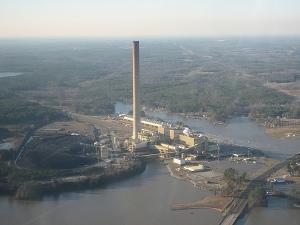
Section Branding
Header Content
Balancing Water Conservation and Energy Needs
Primary Content

More than half the water in Georgia is used to make electricity. From nuclear to hydro-power, just about every river in the state has some kind of power plant on its banks. But as Georgia’s population and energy needs grow, there are concerns about the health of rivers, especially in times of drought. The issue is paramount to conservationists on the Oconee River where a new coal power plant is proposed.
The river runs between Athens in the northeast of the state to Dublin southeast of Macon. Its water produces enough electricity to power 400,000 households. Georgia Power harnesses the force of its flow at two hydro-power dams. But most of the energy comes from the coal plant on the river’s shore at Plant Branch near Milledgeville.
Each day, this factory pumps a billion gallons of water. Coal boils the water into steam thick enough to churn enormous turbines which crank the generator making electricity.
A billion gallons of water sounds like a lot, but most of it returns to the river system.
“About 93 percent of the water that we take out of the river and lakes goes right back in,” says Steven Ewald with Georgia Power. “The water that is consumed is what you see going up in the cooling tower and by evaporation that’s how it cools and you see we’re making clouds basically.”
But new laws make coal energy production more water intensive. They require water return to the river at lower temperatures to protect fish and wildlife. Case in point, another company wants to build Plant Washington further downstream. It would withdraw about 14 million gallons a day and return just one million.
That concerns conservationists, especially, on days like this when there’s a drought, and the river is low and rife with sandbars.
“When you permanently remove 13 to 14 millions gallons of water a day from a river you’re having a pretty big impact on river flows,” says Ben Emanuel with the Altamaha Riverkeeper, “and that has an impact on downstream communities who need clean water supply. It has an impact on need to dilute wastewater from cities and industries. It has an impact on wildlife and sportfish.”
Emanuel says the Oconee can’t handle another power plant. But the Georgia Environmental Protection Division disagrees. The EPD says Plant Washington won’t take water from the river during a drought. It and all new plants, turn to reservoirs or groundwater when the river is critically low.
“Everybody has to maintain low flow,” says Kevin Farrell with the EPD’s Watershed Protection. “So any time we have to do any kind of modeling for effective discharges, it’s all based on that critical condition. So when you design everything for that rare critical condition of protection, the assumption is that every other time, it’s going to be okay.”
Still, Emanuel says Georgia shouldn’t wait until a drought to protect water flows.
“The less water you have in a river, the less water you have to dilute all the pollutants in the river,” says Emanuel. “People don’t often think about the relationship between water quality and water quantity, you really need healthy natural flows to dilute all those pollutants that we discharge on a daily basis.”
Emanuel wants the standard raised. He’s not alone. Farrell says many people from industrialists to city leaders share the concern. But the question remains how to balance conservation and Georgia’s growing water needs.
“The plans are all calling for more research on that topic,” says Farrell. “and it’s open for debate. There’s always the trade-off."
Another consideration, says Farrell, is cost. Stricter regulations would make projects more expensive, for companies and for consumers.
Tags: Georgia Power, drought, Georgia Environmental Protection Division, EPD, Plant Washington, Oconee River, power plants, Plant Branch, coal plants, Altamaha Riverkeeper, Power For Georgians, water plans, coal power plants
